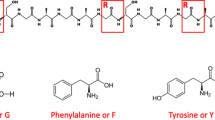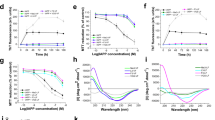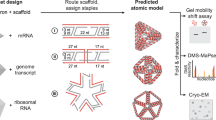Abstract
Amyloid fibrils are ordered, insoluble protein aggregates that are associated with neurodegenerative conditions such as Alzheimer's disease1. The fibrils have a common rod-like core structure, formed from an elongated stack of β-strands, and have a rigidity similar to that of silk (Young's modulus of 0.2–14 GPa)2. They also exhibit high thermal and chemical stability3 and can be assembled in vitro from short synthetic non-disease-related peptides4,5. As a result, they are of significant interest in the development of self-assembled materials for bionanotechnology applications6. Synthetic DNA molecules have previously been used to form intricate structures and organize other materials such as metal nanoparticles7,8 and could in principle be used to nucleate and organize amyloid fibrils. Here, we show that DNA origami nanotubes can sheathe amyloid fibrils formed within them. The fibrils are built by modifying the synthetic peptide fragment corresponding to residues 105–115 of the amyloidogenic protein transthyretin9 and a DNA origami10 construct is used to form 20-helix DNA nanotubes with sufficient space for the fibrils inside. Once formed, the fibril-filled nanotubes can be organized onto predefined two-dimensional platforms via DNA–DNA hybridization interactions.
This is a preview of subscription content, access via your institution
Access options
Subscribe to this journal
Receive 12 print issues and online access
$259.00 per year
only $21.58 per issue
Buy this article
- Purchase on Springer Link
- Instant access to full article PDF
Prices may be subject to local taxes which are calculated during checkout



Similar content being viewed by others
References
Tan, S. Y. & Pepys, M. B. Amyloidosis. Histopathology 25, 403–414 (1994).
Knowles, T. P. J. & Buehler, M. J. Nanomechanics of functional and pathological amyloid materials. Nature Nanotech. 6, 469–479 (2011).
Mesquida, P., Riener, C. K., MacPhee, C. E. & McKendry, R. A. Morphology and mechanical stability of amyloid-like peptide fibrils. J. Mater. Sci. Mater. Med. 18, 1325–1331 (2007).
Guijarro, J. I., Sunde, M., Jones, J. A., Campbell, I. D. & Dobson, C. M. Amyloid fibril formation by an SH3 domain. Proc. Natl Acad. Sci. USA 95, 4224–4228 (1998).
Chiti, F. et al. Designing conditions for in vitro formation of amyloid protofilaments and fibrils. Proc. Natl Acad. Sci. USA 96, 3590–3594 (1999).
Gras, S. L. Amyloid fibrils: From disease to design. New biomaterial applications for self-assembling cross-beta fibrils. Aust. J. Chem. 60, 333–342 (2007).
Seeman, N. C. Nucleic acid junctions and lattice. J. Theor. Biol. 99, 237–247 (1982).
Seeman, N. C. Nanomaterials based on DNA. Annu. Rev. Biochem. 79, 65–87 (2010).
Gustavsson, A., Engstrom, U. & Westermark, P. Normal transthyretin and synthetic transthyretin fragments form amyloid-like fibrils in vitro. Biochem. Biophys. Res. Commun. 175, 1159–1164 (1991).
Rothemund, P. W. K. Folding DNA to create nanoscale shapes and patterns. Nature 440, 297–302 (2006).
Sherman, W. B. & Seeman, N. C. Design of minimally strained nucleic acid nanotubes. Biophys. J. 90, 4546–4547 (2006).
Fitzpatrick, A. W. P. et al. Atomic structure and hierarchical assembly of a cross-β amyloid fibril. Proc. Natl Acad. Sci. USA 110, 5468–5473 (2013).
Jaroniec, C. P., MacPhee, C. E., Astrof, N. S., Dobson, C. M. & Griffin, R. G. Molecular conformation of a peptide fragment of transthyretin in an amyloid fibril. Proc. Natl Acad. Sci. USA 99, 16748–16753 (2002).
Caporini, M. A. et al. Accurate determination of interstrand distances and alignment in amyloid fibrils by magic angle spinning NMR. J. Phys. Chem. B 114, 13555–13561 (2010).
Bongiovanni, M. N., Puri, D., Goldie, K. N. & Gras, S. L. Noncore residues influence the kinetics of functional TTR105–115-based amyloid fibril assembly. J. Mol. Biol. 421, 256–269 (2012).
Bongiovanni, M. N., Caruso, F. & Gras, S. L. Lysine functionalised amyloid fibrils: the design and assembly of a TTR1-based peptide. Soft Matter 9, 3315–3330 (2013).
Gras, S. L. et al. Functionalized amyloid fibrils for roles in cell adhesion. Biomaterials 29, 1553–1562 (2008).
MacPhee, C. E. & Dobson, C. M. Formation of mixed fibrils demonstrates the generic nature and potential utility of amyloid nanostructures. J. Am. Chem. Soc. 122, 12707–12713 (2000).
Glen Report 15.1, A novel route to activated carboxylate modified oligonucleotides. Available from http://www.glenresearch.com//glenreports/gr15-15.html.
Wright, C. F., Teichmann, S. A., Clark, J. & Dobson, C. M. The importance of sequence diversity to the aggregation and evolution of proteins. Nature 438, 878–881 (2005).
Bongiovanni, M. N., Puri, D., Goldie, K. N. & Gras, S. L. Noncore residues influence the kinetics of functional TTR105–115-based amyloid fibril assembly. J. Mol. Biol. 421, 256–269 (2012).
Mesquida, P., Ammann, D. L., MacPhee, C. E. & McKendry, R. A. Microarrays of peptide fibrils created by electrostatically controlled deposition. Adv. Mater. 17, 893–897 (2005).
Mesquida, P., Blanco, E. M. & McKendry, R. A. Patterning amyloid peptide fibrils by AFM charge writing. Langmuir 22, 9089–9091 (2006).
Yang, X. et al. Two-dimensional graphene nanoribbons. J. Am. Chem. Soc. 130, 4216–4217 (2008).
Han, T. H. et al. Peptide/graphene hybrid assembly into core/shell nanowires. Adv. Mater. 22, 2060–2064 (2010).
Li, C., Adamcik, J. & Raffaele Mezzenga, R. Biodegradable nanocomposites of amyloid fibrils and graphene with shape-memory and enzyme-sensing properties. Nature Nanotech. 7, 421–427 (2012).
Seeman, N. C. De novo design of sequences for nucleic acid structure engineering. J. Biomol. Struct. Dyn. 8, 573–581 (1990).
Merrifield, R. B. Solid phase peptide synthesis. I. The synthesis of a tetrapeptide. J. Am. Chem. Soc. 85, 2149–2154 (1963).
Gras, S. L. et al. Functionalized amyloid fibrils for roles in cell adhesion. Biomaterials 29, 1553–1562 (2008).
McPhillips, T. M. et al. Blu-ice and the distributed control system: software for data acquisition and instrument control at macromolecular crystallography beamlines. J. Synchrotron Radiat. 9, 401–406 (2002).
Acknowledgements
This research was supported by the following grants to N.C.S.: grant no. GM-29554 from the National Institute of General Medical Sciences, grants nos CMMI-1120890 and CCF-1117210 from the National Science Foundation, MURI W911NF-11-1-0024 from the Army Research Office, and grants nos N000141110729 and N000140911118 from the Office of Naval Research. M.N.B. was supported by an Australian Nanotechnology Network Overseas Travel Fellowship, a Melbourne Abroad Travelling Scholarship and the Bio21 Institute. S.L.G. and M.N.B. were supported by the Particulate Fluids Processing Centre and S.L.G. by the ARC Dairy Innovation Hub. Part of this research was carried out at the Macromolecular Crystallography beamline at the Australian Synchrotron, Victoria, Australia. Research was carried out in part at the Center for Functional Nanomaterials, Brookhaven National Laboratory, which is supported by the US Department of Energy, Office of Basic Energy Sciences (contract no. DE-AC02-98CH10886).
Author information
Authors and Affiliations
Contributions
A.U., M.N.B., R.J.S., W.B.S. and T.W. carried out experiments and wrote the manuscript. P.S.A. co-designed the peptide conjugation experiments and wrote the manuscript. J.W.C. wrote the manuscript. S.L.G. conceived and directed the project, and wrote the manuscript. N.C.S. conceived and directed the project and wrote the manuscript.
Corresponding authors
Ethics declarations
Competing interests
The authors declare no competing financial interests.
Supplementary information
Supplementary information
Supplementary Information (PDF 4326 kb)
Rights and permissions
About this article
Cite this article
Udomprasert, A., Bongiovanni, M., Sha, R. et al. Amyloid fibrils nucleated and organized by DNA origami constructions. Nature Nanotech 9, 537–541 (2014). https://doi.org/10.1038/nnano.2014.102
Received:
Accepted:
Published:
Issue Date:
DOI: https://doi.org/10.1038/nnano.2014.102
This article is cited by
-
Assembly of peptide nanostructures with controllable sizes
Nano Research (2024)
-
Fabricating higher-order functional DNA origami structures to reveal biological processes at multiple scales
NPG Asia Materials (2023)
-
Functionalizing DNA origami to investigate and interact with biological systems
Nature Reviews Materials (2022)
-
Proximity-induced caspase-9 activation on a DNA origami-based synthetic apoptosome
Nature Catalysis (2020)
-
Programmable Assembly of DNA-protein Hybrid Structures
Chemical Research in Chinese Universities (2020)



